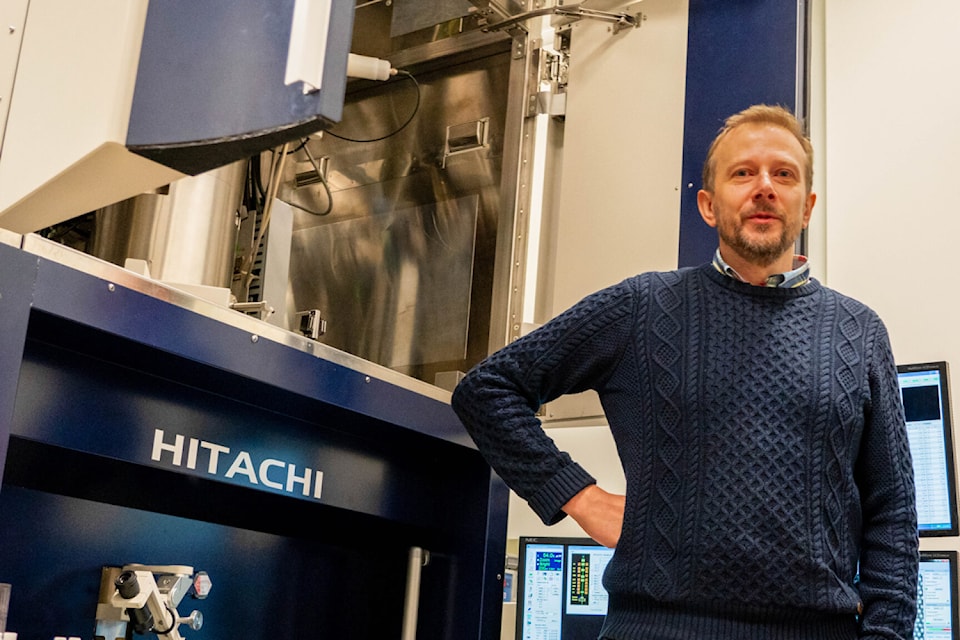Science
University of Victoria Breakthrough Revolutionizes Microscopy

A team of researchers at the University of Victoria has made a significant advancement in the field of electron microscopy. This breakthrough enables scientists to visualize atomic-scale structures using more accessible, lower-cost equipment. Under the leadership of Arthur Blackburn, co-director of the university’s Advanced Microscopy Facility, the team developed a novel imaging technique that achieves sub-Ångström resolution—less than one ten-billionth of a metre.
Traditionally, such high-resolution imaging required large and expensive transmission electron microscopes (TEM). However, this new method employs a compact, low-energy scanning electron microscope (SEM) paired with advanced computational techniques. “This work shows that high-resolution imaging doesn’t have to rely on expensive, complex equipment,” Blackburn stated. As the Hitachi High-Tech Canada Research Chair in Advanced Electron Microscopy, he emphasized the potential of this innovation to democratize access to cutting-edge microscopy.
The research, published in Nature Communications, highlights how this technique opens doors for laboratories worldwide. The approach allows for high-resolution imaging without the prohibitive costs, space requirements, and specialized personnel typically associated with traditional methods. By utilizing overlapping patterns of scattered electrons, the team constructed highly detailed images of samples, achieving a remarkable resolution of just 0.67 Ångström. This size is even smaller than that of an atom and is 1/10,000 the width of a human hair.
This advancement is poised to have transformative effects across various fields, particularly in materials science, nanotechnology, and structural biology. Blackburn noted, “The advance will most immediately benefit the research and production of 2D materials, which are promising in the development of next-generation electronics.” Furthermore, the technique could assist in determining the structures of small proteins, potentially leading to breakthroughs in health and disease research.
Overall, the development at the University of Victoria stands as a pivotal moment in microscopy, offering unprecedented opportunities for scientific exploration and innovation. With this achievement, researchers can now explore atomic structures with greater ease and efficiency, fundamentally shifting the landscape of microscopic imaging.
-

 Politics4 weeks ago
Politics4 weeks agoSecwepemc First Nation Seeks Aboriginal Title Over Kamloops Area
-

 World5 months ago
World5 months agoScientists Unearth Ancient Antarctic Ice to Unlock Climate Secrets
-

 Entertainment5 months ago
Entertainment5 months agoTrump and McCormick to Announce $70 Billion Energy Investments
-

 Science5 months ago
Science5 months agoFour Astronauts Return to Earth After International Space Station Mission
-

 Lifestyle5 months ago
Lifestyle5 months agoTransLink Launches Food Truck Program to Boost Revenue in Vancouver
-

 Technology3 months ago
Technology3 months agoApple Notes Enhances Functionality with Markdown Support in macOS 26
-

 Lifestyle3 months ago
Lifestyle3 months agoManitoba’s Burger Champion Shines Again Amid Dining Innovations
-

 Top Stories2 months ago
Top Stories2 months agoUrgent Update: Fatal Crash on Highway 99 Claims Life of Pitt Meadows Man
-

 Politics4 months ago
Politics4 months agoUkrainian Tennis Star Elina Svitolina Faces Death Threats Online
-

 Sports5 months ago
Sports5 months agoSearch Underway for Missing Hunter Amid Hokkaido Bear Emergency
-

 Politics5 months ago
Politics5 months agoCarney Engages First Nations Leaders at Development Law Summit
-

 Technology5 months ago
Technology5 months agoFrosthaven Launches Early Access on July 31, 2025





















